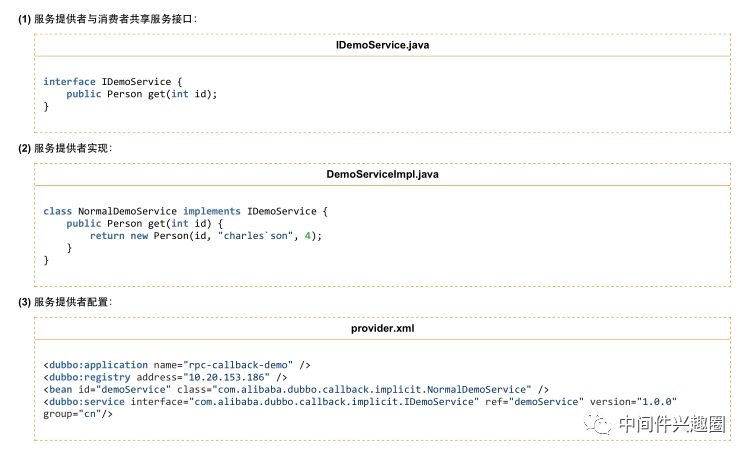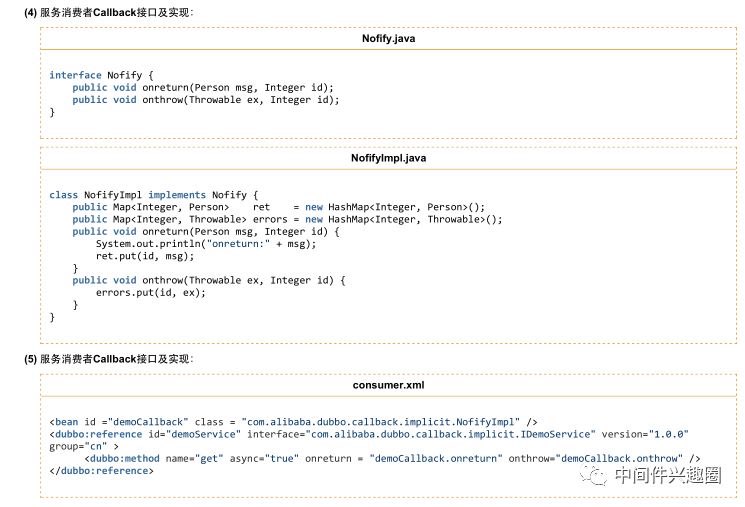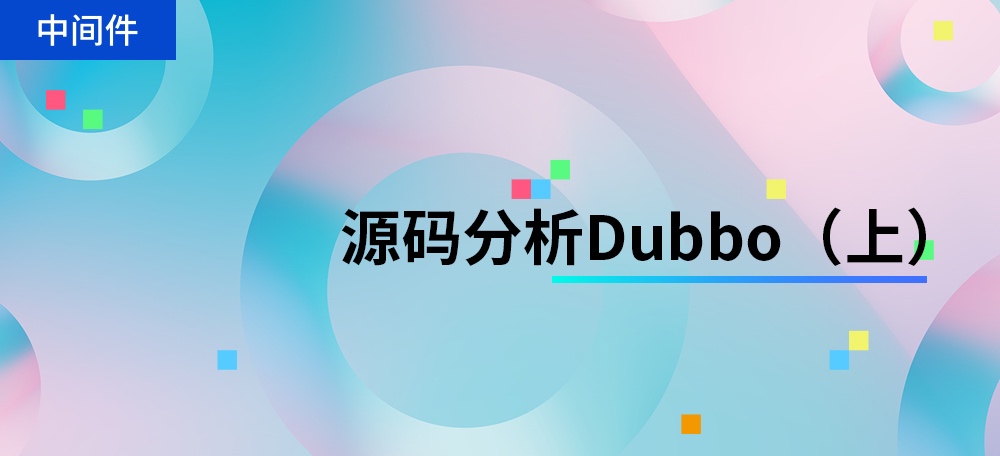源码分析Dubbo异步调用与事件回调机制原创
本文将详细分析Dubbo服务异步调用与事件回调机制。
异步调用与事件回调机制
TTY异步回调
事件回调
异步调用与事件回调机制
在Dubbo中,引入特定的过滤器FutureFilter来处理异步调用相关的逻辑,其定义如下:
1@Activate(group = Constants.CONSUMER)
2public class FutureFilter implements Filter {
3}
group=CONSUMER说明该过滤器属于消费端过滤器。
接下来从从invoke方法详细分析其实现逻辑。
1public Result invoke(final Invoker<?> invoker, final Invocation invocation) throws RpcException {
2 final boolean isAsync = RpcUtils.isAsync(invoker.getUrl(), invocation); // @1
3 fireInvokeCallback(invoker, invocation); // @2
4 // need to configure if there's return value before the invocation in order to help invoker to judge if it's
5 // necessary to return future.
6 Result result = invoker.invoke(invocation); // @3
7 if (isAsync) {
8 asyncCallback(invoker, invocation); // @4
9 } else {
10 syncCallback(invoker, invocation, result); // @5
11 }
12 return result;
13}
- 代码@1:首先从URL中获取是否是异步调用标志,其配置属性为< dubbo:service async=""/>获取其子标签< dubbo:method async=""/>。
- 代码@2:同步调用oninvoke事件,执行invoke方法之前的事件。
- 代码@3:继续沿着调用链调用,最终会到具体的协议Invoker,例如DubboInvoker,发生具体的服务调用,跟踪一下同步、异步调用的实现细节。
- 代码@4:如果调用方式是异步模式,则异步调用onreturn或onthrow事件。
- 代码@5:如果调用方式是同步模式,则同步调用onreturn或onthrow事件。
FutureFilter#fireInvokeCallback
1private void fireInvokeCallback(final Invoker<?> invoker, final Invocation invocation) {
2 final Method onInvokeMethod = (Method) StaticContext.getSystemContext().get(StaticContext.getKey(invoker.getUrl(), invocation.getMethodName(),
3Constants.ON_INVOKE_METHOD_KEY)); // @1
4 final Object onInvokeInst = StaticContext.getSystemContext().get(StaticContext.getKey(invoker.getUrl(), invocation.getMethodName(),
5Constants.ON_INVOKE_INSTANCE_KEY)); // @2
6 if (onInvokeMethod == null && onInvokeInst == null) { // @3
7 return;
8 }
9 if (onInvokeMethod == null || onInvokeInst == null) { // @4
10 throw new IllegalStateException("service:" + invoker.getUrl().getServiceKey() + " has a onreturn callback config , but no such " + (onInvokeMethod == null ? "method" :
11 "instance") + " found. url:" + invoker.getUrl());
12 }
13 if (!onInvokeMethod.isAccessible()) {
14 onInvokeMethod.setAccessible(true);
15 }
16 Object[] params = invocation.getArguments();
17 try {
18 onInvokeMethod.invoke(onInvokeInst, params); // @5
19 } catch (InvocationTargetException e) {
20 fireThrowCallback(invoker, invocation, e.getTargetException()); // @6
21 } catch (Throwable e) {
22 fireThrowCallback(invoker, invocation, e); // @7
23 }
24 }
- 代码@1:StaticContext.getSystemContext()中根据key:serviceKey + “.” + method + “.” + “oninvoke.method” 获取配置的oninvoke.method方法名。其中serviceKey为[group]/interface:[version],其中group与version可能为空,忽略。
- 代码@2:同样根据key:serviceKey + “.” + method + “.” + “oninvoke.instance” 从StaticContext.getSystemContext()获取oninvoke.method方法所在的实例名对象,也就是说该调用哪个对象的oninvoke.method指定的方法。这里就有一个疑问,这些数据是在什么时候存入StaticContext中的呢?下文会详细分析。
- 代码@3、@4:主要检测< dubbo:method oninvoke=""/>配置的正确性,其正确的配置方式如下:“实例名.方法名”,例如:
- 代码@5:根据发射机制,调用oninvoke中指定的实例的指定方法,注意,这里传入的参数为调用远程RPC服务的参数。
注意:从这里可以看出,如果要实现事件通知,也即在调用远程RPC服务之前,之后、抛出异常时执行回调函数,该回调事件的方法的参数列表需要与被调用服务的参数列表一致。
- 代码@6、@7,如果在执行调用前方法(oninvoke)事件方法失败,则会同步调用onthrow中定义的方法(如有定义)。关于dubbo:method oninvoke属性的解析以及在什么时候会向StaticContext.getSystemContext()中添加信息,将在下文统一介绍。
源码分析DubboInvoker关于同步异步调用处理
在上文提到FutureFilter#invoke中的第三步调用invoker.invoker方法时,我们应该会有兴趣了解一下真实的invoker是如何处理同步、异步请求的。
我们以dubbo协议DubboInvoker来重点分析一下其实现原理:
DubboInvoker#doInvoke
1try {
2 boolean isAsync = RpcUtils.isAsync(getUrl(), invocation); // @1
3 boolean isOneway = RpcUtils.isOneway(getUrl(), invocation);
4 int timeout = getUrl().getMethodParameter(methodName, Constants.TIMEOUT_KEY, Constants.DEFAULT_TIMEOUT);
5 if (isOneway) {
6 boolean isSent = getUrl().getMethodParameter(methodName, Constants.SENT_KEY, false);
7 currentClient.send(inv, isSent); // @2
8 RpcContext.getContext().setFuture(null);
9 return new RpcResult();
10 } else if (isAsync) {
11 ResponseFuture future = currentClient.request(inv, timeout); // @3
12 RpcContext.getContext().setFuture(new FutureAdapter<Object>(future));
13 return new RpcResult();
14 } else {
15 RpcContext.getContext().setFuture(null); // @4
16 return (Result) currentClient.request(inv, timeout).get();
17 }
18 } catch (TimeoutException e) {
19 throw new RpcException(RpcException.TIMEOUT_EXCEPTION, "Invoke remote method timeout. method: " + invocation.getMethodName() + ", provider: " + getUrl() + ", cause: " + e.getMessage(), e);
20 } catch (RemotingException e) {
21 throw new RpcException(RpcException.NETWORK_EXCEPTION, "Failed to invoke remote method: " + invocation.getMethodName() + ", provider: " + getUrl() + ", cause: " + e.getMessage(), e);
22 }
- 代码@1:首先获取async属性,如果为true表示异步请求,如果配置了return="false"表示调用模式为oneway,只发调用,不关注其调用结果。
- 代码@2:处理oneway的情况。如果设置了sent=true,表示等待网络数据发出才返回,如果sent=false,只是将待发送数据发到IO写缓存区就返回。
- 代码@3:处理异步的情况,代码@4处理同步调用的情况,细看其实都是通过调用网络客户端client的request,最终调用HeaderExchangeChannel#request方法:
这里是通过Future模式来实现异步调用的,同步调用也是通过异步调用来实现,只是同步调用发起后,直接调用future#get的方法来同步等待结果的返回,而异步调用只返回Future Response,在用户需要关心其结果时才调用get方法。
asyncCallback与syncCallback
前面介绍了方法执行之前oninvoker事件的调用分析,接下来分析RPC服务调用完成后,onreturn和onthrow方法的调用逻辑。
异步回调与同步回调的区别就是调用onreturn(fireReturnCallback)和onthrow(fireThrowCallback)调用的地方不同,如果是同步调用,也就是在完成RPC服务调用后,立即调用相关的回调方法,如果是异步调用的话,RPC服务完成后,通过Future模式异步执行。其实关于onreturn、onthrow属性的解析,执行与oninvoker属性的解析完全一样,再这里也就不重复介绍了。












